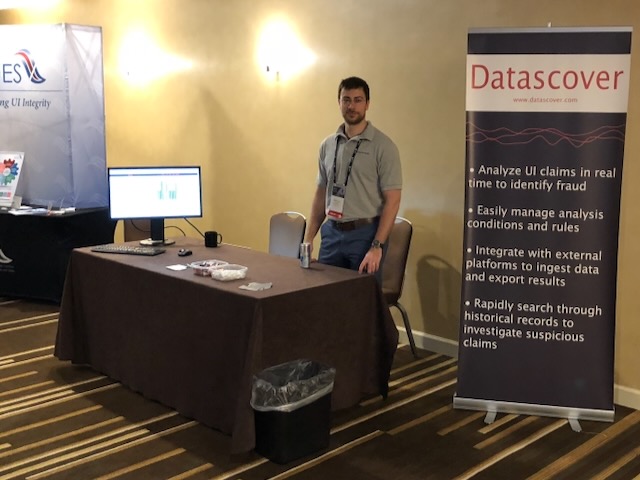Startup Post-Mortem: Datascover
 Shortly after winding down my efforts on
LeagueFab, I launched
my next startup venture: Datascover. At the time, I was working as a full-time
software developer during the day. I had taken a local job after moving to St.
Louis in mid 2015. But I had spent about a year working a freelance job for the
state of Florida prior to that.
Shortly after winding down my efforts on
LeagueFab, I launched
my next startup venture: Datascover. At the time, I was working as a full-time
software developer during the day. I had taken a local job after moving to St.
Louis in mid 2015. But I had spent about a year working a freelance job for the
state of Florida prior to that.
The freelance job was building a custom fraud detection platform for FL’s unemployment insurance program. The state was investing in the platform because they believed individuals were filing for fraudulent benefits using stolen or bogus identities. The program was generally regarded as a success, and saved the state a very substantial sum of money.
Using the dynamic, data driven, rules-based analytics engine, DEO has stopped over 106,000 fraudulent claims, resulting in over $446 million in cost prevention since implementation in January of 2014.
Ever since working on that fraud detection platform and seeing the value of the solution, I kept thinking about how other states must also be experiencing something similar. I knew Florida was ahead of the curve and an early mover with this sort of solution. So in mid 2017, I set about building a configurable fraud detection platform that other states could leverage as a turn-key solution rather than building their own.
This time, I did things differently based on lessons learned from LeagueFab:
-
I built only a true minimum viable product, able to handle basic fraud rules with a UI for demo purposes, but intentionally not a fully developed release.
-
When I was ready to reach out to customers, I filed for a simpler LLC rather than going down the rabbit hole of a Delaware C-corp.
-
And then I began reaching out to state workforce agency leaders to actually talk to prospective customers, with a spreadsheet for a CRM.
This time around, I learned a few different lessons.

Me at a conference for state workforce agencies in early 2018 (I’m clearly not
a designer)
Lesson 1: Not every world is the tech world
Even during my time freelancing for the state of Florida, I was somewhat insulated from the bureaucratic machinations that went on at the leadership level. When trying to sell Datascover’s product, I ran headlong into the quagmire of pretty much every state I interacted with.
On demo calls, I mostly succeeded at presenting myself in a polished, professional manner. I wore a dress shirt, rehearsed my pitch, and positioned a whiteboard on the wall to make my spare bedroom look like it could be a real office meeting room on a Zoom call.
Universally, I interacted with polite professionals on these calls. They were curious about what I had built, and often times saw the theoretical value of such a solution. But they did not have the time or budget to experiment with the theoretical.
In fact, they rarely had any discretionary budget at all. In many cases, any sizeable purchase agreement would have to be approved by the state legislature.
And realistically, the pricing on the product needed to be substantial. There are only 50 states, plus a handful of additional organizations. The market for my product was extremely small, which brings me to…
Lesson 2: Don’t operate in extremely small markets
I think this tweet from the founder of ConvertKit provides some good perspective:
2. Create a list
— Nathan Barry (@nathanbarry) January 15, 2022
When I tried to raise capital all the VCs said our market was far too narrow. But I actually niched down further
I’d go to: “email marketing for professional paleo recipe bloggers who are women”
Or
“Men’s fashion bloggers in NYC”
This type of advice is common (and something we did poorly with LeagueFab). The more specific your initial audience, the more you can really dig in and address the exact needs of your users.
However, the Total Addressable Market should also be sufficiently large to sustain a healthy business and sales pipeline. With LeagueFab, we could have started with the original ping-pong market (targeting even a specific niche within that community) and then slowly expanded our scope to capture additional sports and use-cases over time.
In contrast, Datascover was only useful to 50-ish government entities. It was purpose-built for those organizations. The audience and TAM were too small. I’m sure ConvertKit could find at least 50 female paleo recipe bloggers from that niche alone. Average conversion/closing rates for sales vary by type, but are almost universally below 50%. Add on top of that my inexperience at the time when it came to sales and my lack of reputation as a brand, and it should be unsurprising that after a year of meetings and demos, I had exhausted my pool of contacts without a single commitment from any state.
Conclusion
Datascover taught me a lot about sales. Pick your markets wisely. Understand the buying patterns of your buyers. Understand how their budgets work, and how buying decisions get made.
I think if I could do this over knowing what I know now, I could have found a path to success. I would likely try to partner more closely with a particular state like my own to develop the product and then market it to other states once I had some credibility and warm introductions, rather than trying to get multiple purchase commitments upfront.
But at the end of the day, I think I’d rather just avoid playing in a market that size if I don’t have to.